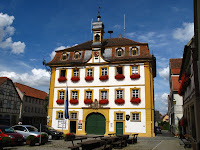 The reason we had detoured some little distance out of our way to be near Erfurt was so we could “collect the set”; but more of that later. On the way between our campsite and Erfurt we made another small detour to visit Weimar; probably not for the same reason that all the German tourists were visiting. We went because it is a UNESCO World Heritage listed town, although why we are not sure.
The reason we had detoured some little distance out of our way to be near Erfurt was so we could “collect the set”; but more of that later. On the way between our campsite and Erfurt we made another small detour to visit Weimar; probably not for the same reason that all the German tourists were visiting. We went because it is a UNESCO World Heritage listed town, although why we are not sure.  It is famous for being home to Goethe, Shiller, Liszt, Bach, Strauss, Nietzsche and others and of course for giving its name to the short-lived Weimar Republic.
It is famous for being home to Goethe, Shiller, Liszt, Bach, Strauss, Nietzsche and others and of course for giving its name to the short-lived Weimar Republic.Although a pleasant enough spot for a coffee stop we had seen better towns on this trip that would seem more worthy of a UNESCO listing so we moved on to Erfurt, once again frustrated in our initial attempts by road closures.
 Erfurt is home of the Kramerbrucke; a bridge lined on both sides with shops that gives no indication as you approach that you are anywhere other than on a normal city street. There are four bridges in the world with shops on both sides and today we collected the set as we crossed the last of the four. (Rialto, Venice; Ponte Vecchio, Florence; and Pulteney Bridge, Bath are the other three.) Kramerbrucke may not be the most well known but it is most appealing.
Erfurt is home of the Kramerbrucke; a bridge lined on both sides with shops that gives no indication as you approach that you are anywhere other than on a normal city street. There are four bridges in the world with shops on both sides and today we collected the set as we crossed the last of the four. (Rialto, Venice; Ponte Vecchio, Florence; and Pulteney Bridge, Bath are the other three.) Kramerbrucke may not be the most well known but it is most appealing.Although we had really come just for the bridge, we spend a pleasant few hours exploring this delightful centre that has survived in its current state mainly because it was behind the Iron Curtain when the rest of the world was in “tear down and modernise” mode.
 However, we had now strayed a considerable distance from our intended path so it was back on the autobahns for a dash down to the Rhine Valley and our next campsite, just outside of Koblenz. When not slowed for the all-too-frequent road improvement works, the German autobahns are a real pleasure to drive: slower drivers understand about moving to the slow lanes rather than hogging the centre or fast lane as they do in the UK and when there are no
However, we had now strayed a considerable distance from our intended path so it was back on the autobahns for a dash down to the Rhine Valley and our next campsite, just outside of Koblenz. When not slowed for the all-too-frequent road improvement works, the German autobahns are a real pleasure to drive: slower drivers understand about moving to the slow lanes rather than hogging the centre or fast lane as they do in the UK and when there are no  limits posted, anything goes.
limits posted, anything goes.Cruising at around 100mph there are still many cars that pass you as though you are standing still and you have to be ever watchful when pulling out to pass as these vehicles fill your rear view mirror at an alarming rate.
 Continental summer was at its best with shade temperatures in excess of 30C so we stopped off at Weilburg, on a bend in the River Lahn, for a refreshing Iced Coffee before completing the final leg to our delightful campsite, on the banks of the River Lahn, just before it feeds into the Rhine.
Continental summer was at its best with shade temperatures in excess of 30C so we stopped off at Weilburg, on a bend in the River Lahn, for a refreshing Iced Coffee before completing the final leg to our delightful campsite, on the banks of the River Lahn, just before it feeds into the Rhine.















































